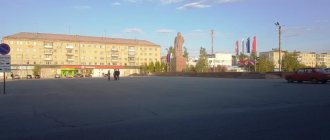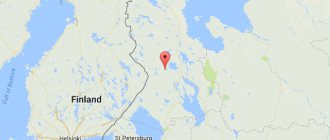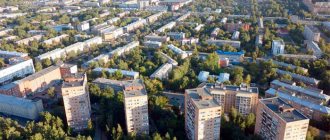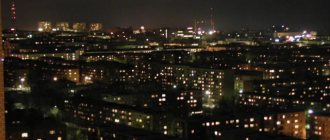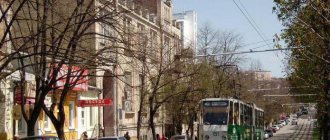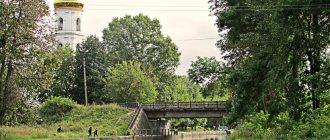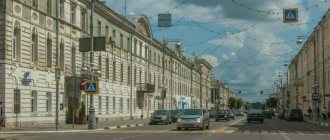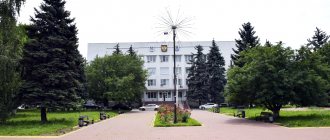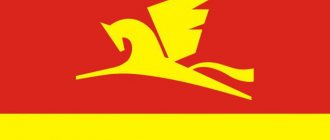More about the districts of the Saratov region here.
Balashov is the largest city in the west of the Saratov region, it is located in the valley of the Khoper River. The city is located 210 km from Saratov. It is located at the intersection of two railway lines, Tambov-Kamyshin and Penza-Povorino.
Buses and minibuses depart from the bus station to neighboring settlements. Not far from the city there is the military town of Balashov-13 and a military airfield.
About the city of Balashov
During the period of the first development of the Saratov region, fugitives from central Russia in the seventeenth century built a small farm on the site of modern Balashov. The peasant Vasily Balashka settled here, then the farm grew into a small village. The city was founded in 1780 , based on a decree of Empress Catherine II.
Empress Catherine II
His specialization was servicing agricultural production. At the beginning of the 19th century, the newly founded city had already become the 10th largest settlement in the Saratov province. It is developing rapidly, becoming an industrial and economic center.
In the 30s of the 19th century, just over 2 thousand people lived here, but by 1859 this number grew to 6600. During this period, a pier was created in the city, used mainly for grain rafting.
Immediately after the reforms of Alexander the Second, a parish school appeared in Balashov. Later, a men's and women's gymnasium, a four-year school, and religious and vocational schools were opened. In 1897, there were 5 schools and 7 churches in the city, and there was a zemstvo hospital.
The merchant class was traditionally responsible for the development of the city's economy. Large fairs were held in Balashov, there were 4 of them - Evdokia, Troitskaya, Rozhdestvenskaya, Ilyinskaya.
Factories were built, and if oil mills, tallow-making and brick production were characteristic of each settlement of the province, the construction of an iron foundry and a mechanical workshop already spoke of the industrial status of the city. There were abundant black soils around the city, and the growing crops were processed in 6 steam mills.
Trade was actively developing; on Trinity Square and the central streets of the city one could see textile, fur, sausage shops, bakeries, confectioneries, and Singer and Ford representative offices.
In 1891, construction of railways passing through Balashov began. After the construction of two lines and the construction of a bridge across the Khoper River, the city began to develop even more actively.
Distillery in Balashov
In 1907, 25 thousand people already lived here. Soviet power in the city was proclaimed on November 19, 2022. In 1928, the Balashovsky district was created. Its rapid industrial development began, existing production facilities were reconstructed, and a power plant was built.
During the Second World War, aviation was evacuated here from Kyiv, more than 29 hospitals operated, and an armored school transferred from Orel was opened.
It is interesting that Balashov was at one time a regional center. The Balashov region, made up of the regions of Saratov, Voronezh, Stalingrad and Tambov, existed from 1954 to 1957.
This period was marked by an accelerated expansion of industrial potential. Machine-building and car repair plants opened, and processing developed. After the gateway to the Saratov region, a mica plant opened here. Now Balashov is the largest economic center of the region after Saratov on the Right Bank of the region.
Geographical features
One of the most beautiful rivers in Russia, the Khoper River, flows directly through this regional center. It is a tributary of the Don River. Two railway lines converge in the city: Povorino-Penza and Tambov-Kamyshin.
The climate in Balashov is temperate continental. The coldest month is February (t -8 °C), and the warmest month is July (t +21.1 °C). The average annual air temperature is +6.4 degrees. The annual precipitation is 525 mm.
Photographs of Balashov show that it is a fairly large provincial town. The houses are modest and fairly well maintained, both small and medium in size. The roads are varied, and the buildings are quite chaotic.
Coat of arms of Balashov
The official heraldic reference book about the coat of arms of Balashov says: “In gold there are two green watermelons, tied at the head with stems; Each stem of the plant has three leaves.
Coat of arms of Balashov
In the free part there is the coat of arms of the Saratov region (three silver sterlets placed in a fork-shaped cross, facing in an azure field).” It is interesting that the coat of arms almost completely reproduced the one granted to the city by the highest decree in 1780. Watermelons signified the city's abundance of these fruits, which makes one think about who grew them and where they learned about Balashov watermelons in St. Petersburg.
Education and culture of Balashov
The city is not only the economic, but also the educational and cultural center of the region. Branches of all regional universities operate here. Students do not need to move to Saratov to get an education.
Education for children is provided not only by secondary schools, but also by 2 gymnasiums and a lyceum. There is a children's creativity center and an educational center that ensure the creative development of schoolchildren.
The Balashov Drama Theater, which opened in 1918, invites townspeople to its performances. The props were entirely composed of everyday elements requisitioned from the merchant class. There are several cinemas.
There are 5 musical ensembles performing in the city, including the Cossack group “Khoperskaya Volnitsa”. The Church of the Archangel Michael and 5 other churches invite Orthodox Christians to services. It was built in the eighteenth century and completely rebuilt in the 19th at the expense of the merchant I.P. Borodulin.
Plans for the regional center
The resolution covered almost all aspects of life in the created region. In Balashov, it was planned to increase the capacity of the existing power plant and water supply system, reconstruct the bakery, improve the station area, establish a direct railway connection between Balashov and Moscow and a suburban connection between Balashov and Rtishchevo.
It was planned to build a cinema with 330 seats, a printing house, a regional library with 50 thousand volumes, shops, canteens, etc. in the city.
Much attention was paid to the construction of housing, new industrial enterprises and reconstruction of existing ones.
It was planned to build a refrigeration equipment plant, a furniture factory, a metalworking plant, a motor repair plant, a clothing, pasta and confectionery factory, a brewery and other enterprises.
The complexity of the situation was that at the end of 1953 there was not a single construction organization in the city. At the beginning of 1954, the Balashov Administration “Stalingradmetallurgstroy”, the design office “Oblproekt”, and the trust “Balashovstroy” were created. By 1956, a construction department of the regional consumer union, a construction department of the Gortop, a construction department of the regional department of internal affairs, and a railway construction and installation column were created.
The city begins to grow rapidly. On October 28, 1954, with a large crowd of people, laying the foundation for the central mass of the building of the House of Soviets began. Already in 1955, more than 13 thousand square meters were put into operation in the city. residential area, dozens of buildings with a living area of about 30 thousand sq.m. were under construction. However, the quality of construction was poor. A big defect, for example, occurred during the construction of the Spartak cinema. Construction projects were located on more than 30 streets and alleys; individual points were interspersed in old neighborhoods, often not even on the streets, but in the courtyards. This delayed the optimal architectural design of the city for many years and delayed construction due to the inability to use industrial construction methods. But there was probably no other way out at that time, because... There was a catastrophic shortage of housing; they were built where the minimum number of residential buildings were to be demolished.
In 1955, the first stage of the asphalt mixing plant was put into operation, which expanded the possibilities for improving the city.
A significant obstacle to urban renewal was the low capacity of the power plant. In this regard, in addition to increasing the power of the power plant, a decision was made to launch an energy train. The creation of a mobile power station, consisting of 13 cars, required significant costs and time.
Streets and sights of Balashov
The city's layout is a traditional product of the city planning of Catherine's time, when all new cities were built according to a single regular plan. Khoper divides the city into two unequal parts.
In one of them you can see administrative buildings and modern multi-storey buildings, the second is given over to the private sector. In the 20th century, Balashov had only 22 streets and alleys, 2,500 households, 2 squares and a public garden.
Since then the city has grown significantly. The main faces of the city are Sovetskaya, Lenin Street, which is 7 km long, and the busy shopping street of Karl Marx.
Travelers who visited the city could not always fully appreciate its architectural style, which has changed significantly since Catherine’s times, but everyone fondly remembers the cozy green streets of the regional center. The local history museum became the center of the historical and cultural life of Balashov.
Balashovsky Museum of Local Lore
The website of the Balashov Local History Museum is here. It is located in a building with interesting architecture, a bit reminiscent of the walls and towers of the Moscow Kremlin. The moment of its foundation dates back to the 30s of the twentieth century. Now in its storerooms and exhibitions there are 40 thousand storage units dating back to the period of history from the Mesolithic to the present day.
Particularly interesting are ancient photographs, wardrobe and household items, and artisans' tools. New exhibitions that open regularly introduce citizens and visitors to the nature, culture, and ancient families of the Balashov region.
A branch of the museum was opened in the house of the merchant Dyakov. This is an interesting wooden building, the design of which combines such styles as Art Nouveau, Rococo, and Baroque. The interiors, parquet flooring, tiled stoves are well preserved.
The city’s monuments also include the Pobeda cinema, the building of which has existed since the 19th century.
Cinema Pobeda in Balashov
The website of the Pobeda cinema in Balashov is here. A visit to Balashov will become a bright page in everyone’s life; its dim beauty will remain in the memory for a long time.
Population
In 2022, the population of Balashov was 77 thousand 391 people. According to this indicator, the city is in 214th place among Russian cities. Population dynamics show a picture typical of many Russian provincial centers: rapid population growth during the Soviet period, a cessation of growth in the 90s and a decline from 2000 to the present. In 1913, 26,900 people lived in the city, and in 1987 - 99,000 people. Back in 2003, there were 98,300 people in Balashov, after which the population only decreased. This is probably due to the closure of a number of enterprises.
The population density of Balashov is 1125.5 people/sq. km.
The national composition is sharply dominated by Russians. There are 97 percent of them. Ukrainians follow with a large margin (1.4%). In third place are Azerbaijanis (0.7%). In fourth place are Armenians (0.4%). The share of other peoples is insignificant.
The residents of Balashov are called Balashovtsy, and one particular resident is called Balashovets.
Neighborhoods of Balashov
When visiting the city, you should not forget to explore the attractions of the area. The Khoper is considered one of the most beautiful rivers in central Russia.
Not far from Balashov there are ancient noble estates Padakh, Otradino, Bobylevka, Zubrilovka. They were visited by Lermontov, Polonsky, Derzhavin, Krylov, and the composer Rachmaninov.
Thus, Zubrilovka, one of the most famous estates in the entire Volga region, formerly belonged to the princes Golitsyn-Prozorovsky.
G.A. Potemkin, a famous nobleman of the era of Catherine II, contributed to the acquisition of this estate by the Golitsins. The great poet Gavrila Ranovich Derzhavin, and later the artist Viktor Borisov-Musatov, often visited here. Here he painted the painting “Ghosts”.
When studying the Saratov region, one cannot ignore Balashov. This ancient merchant city still attracts attention with its active life and interesting architecture.
Medical service
Much has changed in the medical care of citizens: the construction of the third regional hospital has been completed, a new city hospital has been opened, neurological and traumatology departments have been opened, a regional sanitary and aviation station, an ambulance station, etc. The improvement of the qualifications of medical workers was evidenced by regional congresses of doctors and paramedical workers, and the creation of a scientific society of obstetricians and gynecologists. The cultural life of the young region was quite rich. When studying the issues of “Balashovskaya Pravda” of this period, one notices the abundance of publications devoted to the drama theater. Here are stories about premieres, tours, articles from theater critics, stories about meetings between actors and audiences. The theater staff during these years increased from 19 to 80 people. Regional song festivals attracted up to 20 thousand spectators.
On June 15, 1957, the opening of a youth festival took place in Balashov, held under the slogan “For peace and glorious work.” After the parade and the next day, amateur art competitions, sports competitions, games, and mass celebrations took place in all parts of the city and beyond Khopry.
